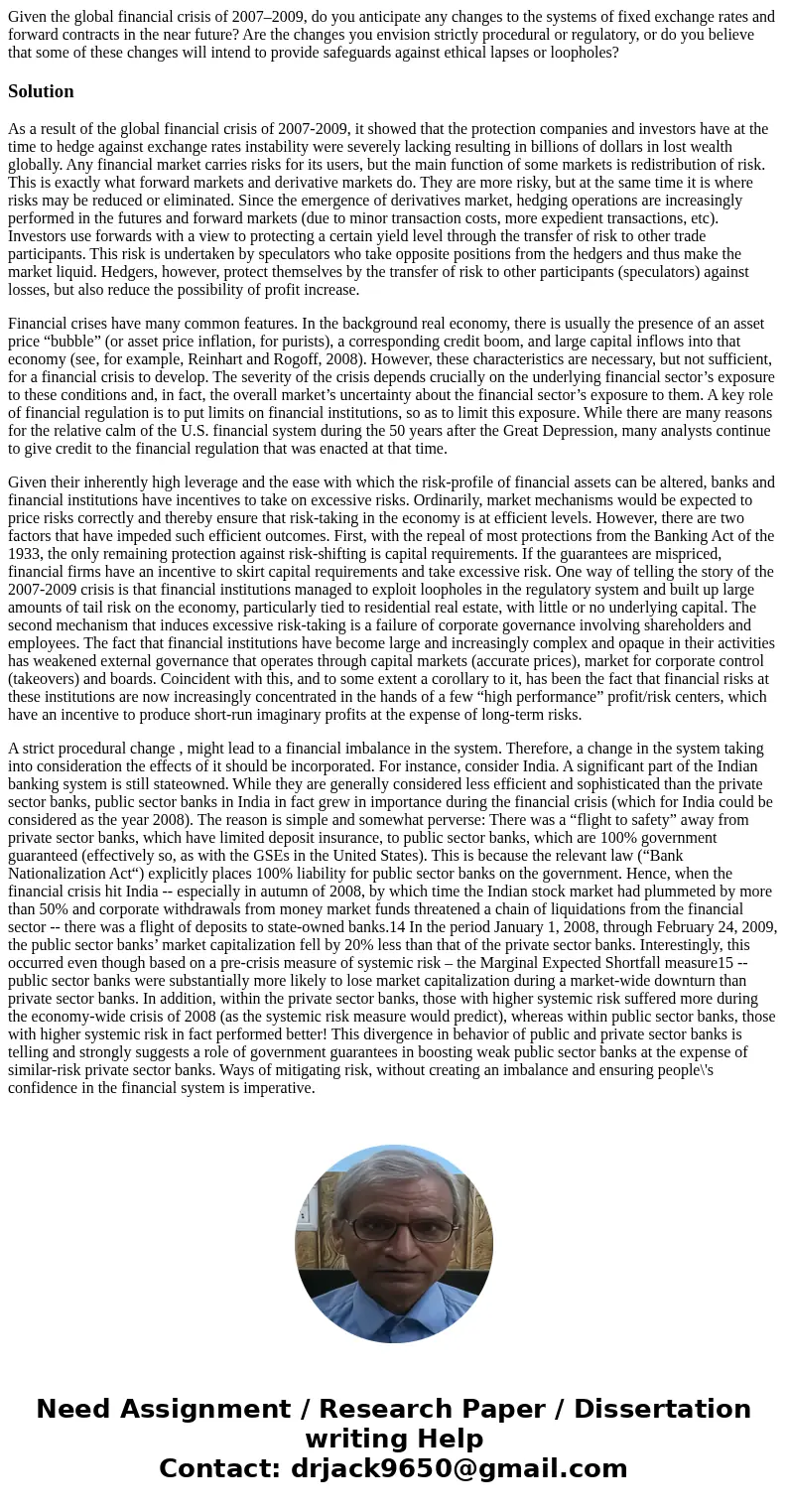Given the global financial crisis of 20072009 do you anticip
Given the global financial crisis of 2007–2009, do you anticipate any changes to the systems of fixed exchange rates and forward contracts in the near future? Are the changes you envision strictly procedural or regulatory, or do you believe that some of these changes will intend to provide safeguards against ethical lapses or loopholes?
Solution
As a result of the global financial crisis of 2007-2009, it showed that the protection companies and investors have at the time to hedge against exchange rates instability were severely lacking resulting in billions of dollars in lost wealth globally. Any financial market carries risks for its users, but the main function of some markets is redistribution of risk. This is exactly what forward markets and derivative markets do. They are more risky, but at the same time it is where risks may be reduced or eliminated. Since the emergence of derivatives market, hedging operations are increasingly performed in the futures and forward markets (due to minor transaction costs, more expedient transactions, etc). Investors use forwards with a view to protecting a certain yield level through the transfer of risk to other trade participants. This risk is undertaken by speculators who take opposite positions from the hedgers and thus make the market liquid. Hedgers, however, protect themselves by the transfer of risk to other participants (speculators) against losses, but also reduce the possibility of profit increase.
Financial crises have many common features. In the background real economy, there is usually the presence of an asset price “bubble” (or asset price inflation, for purists), a corresponding credit boom, and large capital inflows into that economy (see, for example, Reinhart and Rogoff, 2008). However, these characteristics are necessary, but not sufficient, for a financial crisis to develop. The severity of the crisis depends crucially on the underlying financial sector’s exposure to these conditions and, in fact, the overall market’s uncertainty about the financial sector’s exposure to them. A key role of financial regulation is to put limits on financial institutions, so as to limit this exposure. While there are many reasons for the relative calm of the U.S. financial system during the 50 years after the Great Depression, many analysts continue to give credit to the financial regulation that was enacted at that time.
Given their inherently high leverage and the ease with which the risk-profile of financial assets can be altered, banks and financial institutions have incentives to take on excessive risks. Ordinarily, market mechanisms would be expected to price risks correctly and thereby ensure that risk-taking in the economy is at efficient levels. However, there are two factors that have impeded such efficient outcomes. First, with the repeal of most protections from the Banking Act of the 1933, the only remaining protection against risk-shifting is capital requirements. If the guarantees are mispriced, financial firms have an incentive to skirt capital requirements and take excessive risk. One way of telling the story of the 2007-2009 crisis is that financial institutions managed to exploit loopholes in the regulatory system and built up large amounts of tail risk on the economy, particularly tied to residential real estate, with little or no underlying capital. The second mechanism that induces excessive risk-taking is a failure of corporate governance involving shareholders and employees. The fact that financial institutions have become large and increasingly complex and opaque in their activities has weakened external governance that operates through capital markets (accurate prices), market for corporate control (takeovers) and boards. Coincident with this, and to some extent a corollary to it, has been the fact that financial risks at these institutions are now increasingly concentrated in the hands of a few “high performance” profit/risk centers, which have an incentive to produce short-run imaginary profits at the expense of long-term risks.
A strict procedural change , might lead to a financial imbalance in the system. Therefore, a change in the system taking into consideration the effects of it should be incorporated. For instance, consider India. A significant part of the Indian banking system is still stateowned. While they are generally considered less efficient and sophisticated than the private sector banks, public sector banks in India in fact grew in importance during the financial crisis (which for India could be considered as the year 2008). The reason is simple and somewhat perverse: There was a “flight to safety” away from private sector banks, which have limited deposit insurance, to public sector banks, which are 100% government guaranteed (effectively so, as with the GSEs in the United States). This is because the relevant law (“Bank Nationalization Act“) explicitly places 100% liability for public sector banks on the government. Hence, when the financial crisis hit India -- especially in autumn of 2008, by which time the Indian stock market had plummeted by more than 50% and corporate withdrawals from money market funds threatened a chain of liquidations from the financial sector -- there was a flight of deposits to state-owned banks.14 In the period January 1, 2008, through February 24, 2009, the public sector banks’ market capitalization fell by 20% less than that of the private sector banks. Interestingly, this occurred even though based on a pre-crisis measure of systemic risk – the Marginal Expected Shortfall measure15 -- public sector banks were substantially more likely to lose market capitalization during a market-wide downturn than private sector banks. In addition, within the private sector banks, those with higher systemic risk suffered more during the economy-wide crisis of 2008 (as the systemic risk measure would predict), whereas within public sector banks, those with higher systemic risk in fact performed better! This divergence in behavior of public and private sector banks is telling and strongly suggests a role of government guarantees in boosting weak public sector banks at the expense of similar-risk private sector banks. Ways of mitigating risk, without creating an imbalance and ensuring people\'s confidence in the financial system is imperative.

 Homework Sourse
Homework Sourse